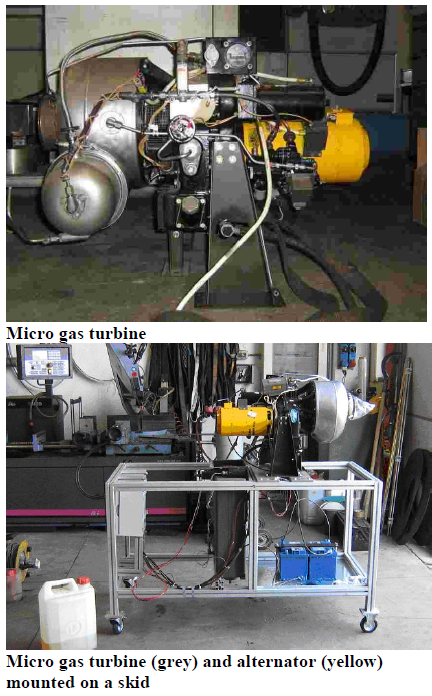(Micro) Gas Turbines (MGT)
MGTs are small, compact high-speed (up to 120000 rpm) turbo-generators with power output up to 200 kWe that operate on a Brayton cycle and usually consist of a centrifugal compressor, a radial turbine and a permanent magnet alternator. When connected to a thermally activated cooling technologies, they deliver energy in the form of electricity, heat or cooling close to the point where it is needed.
Depending on the size of the machine and on the final use (power, cogeneration or trigeneration), a regenerative scheme might be adopted in order to decrease the specific consumption, obtaining higher electrical efficiencies. In this configuration, the incoming atmospheric air is first filtered and used as a cooling medium for the alternator and electronic devices. The air leaving the alternator is later compressed and passed through the regenerator, where it is preheated with the hot gases leaving the turbine ,before entering the combustion chamber. Inside the combustion chamber, compressed fuel (either gaseous or liquid) is burned with compressed air to produce hot gases at high temperature and pressure. This is then expanded through the turbine, which drives the compressor and the alternator. The turbine exhaust gas is fed through the regenerator and then redirected to heat recovery device, such as a steam or hot water generator, a directly driven absorption chiller, a desiccant cooling system, or any other process that can benefit from high temperature (up to 450°C in a regenerative configuration).
Micro and medium size gas turbines have been proven to safely run on some renewable fuels, such as pure or diesel blended biodiesel, while the use of pure vegetable has not yet been demonstrated. A small number of attempts have been made by researchers to run this kind of turbomachines with pure pyrolysis oil and pyrolysis oil-diesel emulsion.
Project progress
 The University of Florence (UFL) has carried out a survey on available micro gas turbines (MGT), comparing technical characteristics towards needed modifications. The MGT architecture was carefully examined, as the possibility to implement minor modifications largely depends on the type of MGT: issues such as combustion–chamber type, injector characteristics, fuel line and control system were the driving factor for comparing the various options. The Garrett GTP 30-67 was finally selected and procured. This is a small-size gas turbine, single-stage centrifugal compressor, radial inward-flow turbine wheel. The main components are the fuel control unit, the fuel solenoid valve and the fuel atomizer. A test bench for the MGT was designed and constructed (see pictures). The MGT normally runs on conventional diesel and is being modified to allow the combustion of bioliquids, including plant oils, biodiesel, upgraded pyrolysis oils and mixtures or emulsions. Only minor modifications were considered. To help determine what modifications were needed, UFL carried out a review of the combustion behaviour of a pyrolysis oil droplet.
The University of Florence (UFL) has carried out a survey on available micro gas turbines (MGT), comparing technical characteristics towards needed modifications. The MGT architecture was carefully examined, as the possibility to implement minor modifications largely depends on the type of MGT: issues such as combustion–chamber type, injector characteristics, fuel line and control system were the driving factor for comparing the various options. The Garrett GTP 30-67 was finally selected and procured. This is a small-size gas turbine, single-stage centrifugal compressor, radial inward-flow turbine wheel. The main components are the fuel control unit, the fuel solenoid valve and the fuel atomizer. A test bench for the MGT was designed and constructed (see pictures). The MGT normally runs on conventional diesel and is being modified to allow the combustion of bioliquids, including plant oils, biodiesel, upgraded pyrolysis oils and mixtures or emulsions. Only minor modifications were considered. To help determine what modifications were needed, UFL carried out a review of the combustion behaviour of a pyrolysis oil droplet.
Furthermore, UFL developed a three-dimensional Computational Fluid Dynamics (CFD) model of the combustion chamber, to study the aerodynamics of the combustor and predict the droplet’s paths when the fuelling will be switched to bioliquids.



